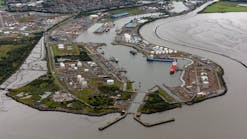Fatmir Shehu
Albanian National Oil Co.
Fier, Albania
Daniel Johnston
Daniel Johnston & Co. Inc.
Dallas
The technical and economic performance of drilling operations in Albania has improved during the past few years, though it has not reached a high level. The low performance results from geological complications and the use of old equipment with low capacities.
Most of the rigs do not have adequate hydraulic or kinematic systems. Low quality spare parts, a lack of imported material, and infrequent maintenance cause downtime from mechanical failures. The average time spent drilling is only 25-40% of the time on location, and the average drilling rate is about 4-5 m/hr.
Oil well drilling in Albania started in 1918 with a discovery well drilled in the Vlora zone (Drashovice) to a depth of about 200 m. Since then, over 5,000 wells have been drilled in Albania (Fig. 1). Table 1 lists the total meterage drilled in Albania for both exploration and production wells for the past few years. Note the high levels in the late 1980s when meterage reached about 400,000 m/year.
PRODUCTION
Of the 3,000 wells still producing, around 2,000 produce oil, and around 1,000 produce gas. Oil production averages 3,000 tons/day (20,000 bo/d), split between the fractured Ionian carbonates and the Miocene sandstones which unconformably overlay the carbonates. Total gas production averages over 1 million cu m/day (35 MMcfd). These figures break down to 1.5-3.0 tons/day (7-15 bo/d) per oil well and 1,000-1,500 cu m/day (30-50 Mcfd) per gas well (Table 2).
Heavy oil accounts for approximately half of the oil production in Albania. Most of this production comes from the Marinze field complex which produces both heavy and light oil. Estimates for the original oil in place (heavy oil) at Marinze range around 200 million tons (1.0-1.2 billion bbl). The Marinze field was discovered in 1927 and developed in 1944. Since 1944, over 2,000 wells have been drilled in the field, and it has produced about 12 million tons (70 million bbl).
The sandstone reservoirs dip about 12 to the northwest, and the shallower Gorani and Driza sands outcrop to the southeast (Fig. 2). Because of this, the younger, shallower sands contain the heavy oils. The shallow Gorani sands have extremely heavy oil approaching tar and bitumen.
The sandstones are generally clean, porous sands with some interbedded-laminated montmorillonitic shales. The sandstones are generally unconsolidated, causing numerous production problems.
The "type" well for the Marinze field sandstones is the Marinze 26-25 well. It encountered 14 sands (174 m of net sand) between 1,583 m and 1,879 m. In this well, the average sand thickness is 12.4 m, average porosity is 21%, and average water saturation is 35%.
The sandstone section is characterized by multiple pay zones, typically seven to ten sands in the Marinze field area (Table 3). Other fields generally have fewer productive sands and smaller areal extent.
Albania's gas fields are located on the coastal sector northeast of the main oil producing region (Fig. 3). The dry biogenic gas is produced exclusively from the sandstone reservoirs. The country's deepest well was drilled in the Ardenica anticline to a depth of 6,700 m, but it did not reach the Ionian carbonates.
The Vlora-Lushnje-Elbasan-Diber fault geologically separates the oil fields to the southeast from the gas fields. The northern-most gas field is named after the nearby port city of Durres, and gas seeps have been reported in this area.
Additional gas production comes from the associated gas in the oil fields and from gas condensate and gas cap reservoirs in the carbonates to the southeast.
The geological structures encountered are of Neogen and Paleogen ages. The typical lithologies in the well sections include shale, limestone, flysch, and halogene formations,
The pay zones include the Tortonian (oil and gas), Pliocene (gas), and Eocene limestone (oil, gas, and gas condensate).
OPERATIONS MANAGEMENT
Albanian drilling operations are under six enterprises in the oil territories: Saranda, Vlora, Patos (2), Kucove, and Lushnje. The enterprise in Lushnje drills the gas exploration and production wells.
Another enterprise handles infill drilling with 20 rigs that drill wells solely for steam injection, water injection, and CO2 injection. The remaining five enterprises have about 40 rigs.
Each enterprise has a relatively large group of technical and engineering personnel, with a total of about 150 drilling engineers.
In addition to daily drilling operations, each drilling enterprise rigs up and rigs down its rigs. Specialized enterprises handle the support operations like cementing, logging, road and location construction, communication and transportation, and equipment service.
The drilling enterprises are under the direction of the General Directorate of Oil and Gas (DPNG) in Patos. The DPNG is under the Ministry of Industry, Mines, and Energy.
The Technological Research and Design Institute in Patos handles technological drilling projects and studies the problems encountered in drilling. The drilling engineers at the institute study drilling muds, cementation, formation mechanics, formation pressure gradients, deviated drilling, and horizontal drilling.
DRILLING RIGS
The drilling rigs used in Albania are manufactured in either the U.S.S.R. or in Romania. Fig. 4 shows a group of Albanian roughnecks on a workover rig last January. The rig farm predominantly contains Romanian 3DH, F-200, and F-320 rigs and Soviet 3D and 5D rigs. Note the derrick construction on a typical Soviet 5D rig shown in Fig. 5. Table 4 lists some of the general operating characteristics of each of these five types of rig. The Soviet 3D rigs are typically used to drill wells about 4,500 m deep in abnormally pressured sections (with drilling mud densities up to 2 g/cc). Wells 4,000-5,000 m deep are typically drilled with Romanian 3DH and F-200 rigs.
In 1988, Albania drilling specialists drilled the country's deepest well, Ardenica18, to a depth of 6,700 m (21,975 ft). This well was drilled with a Romanian F-320 rig modified with Caterpillar engines.
Despite the depths reached by the Romanian and Soviet rigs, the technological features of these rigs make them inappropriate for deep well drilling. The use of these rigs for deep well drilling has resulted in low technical and economic performance. These rigs have serious limitations in hydraulic power, measurement and control automation, substructure construction, drilling mud treatment systems, and overall kinematics.
The local mechanical shops make most of the upgrades, modifications, and repairs to the drilling rigs.
DOWNHOLE EQUIPMENT
The 5 1/2-in. and 4 1/2-in. drill pipe used comes from Western stock (that is, modern-standards drill pipe manufactured in Germany, Japan, or Italy).
For deep drilling, the rigs use 3 1/2-in. Grade E or G-105 drill pipe also manufactured in the West.
The use of Western drill pipe has decreased drill pipe failure time considerably during the last decade (from 47 cases in 1981 to 16 cases in 1985).
Weight on bit is provided by standard drill collars available in the following sizes: 259 mm, 229 mm, 203 mm, 178 mm, 165 mm, 146 mm, and 120 mm OD.
The stabilizers run to combat well bore deviation come in various shapes and constructions, and most are manufactured in Albania. One limitation of these stabilizers is the quicker decrease in their OD compared to that of the bit. This problem results from a lack of strengthening of the stabilizers with strong compounds and from a general increase in on-bottom time. The newer, self-lubricating-bearing bits wear slowly, allowing longer periods of drilling.
Most of the drilling applications have used roller cone bits of Western (for example, Reed Tool Co. or Hughes Tool Co.), Romanian, or domestic design. Unfortunately, despite efforts by the drilling enterprises, the domestic roller cone bits have not shown satisfactory economical-technical performance.
Diamond drilling bits are used much less often than roller cone bits. Eastman Christensen and Diamant Boart Stratabit have supplied most of the diamond bits. Yet, diamond bit performance has been unsatisfactory because the available rigs do not have the appropriate hydraulic horsepower, resulting in occasional failures. However, Stratapax R-422 bits have been used with some success in the deeper wells.
Downhole motors have had limited use in the Albanian fields. The Soviet drilling turbines and Eastman Christensen helicoidal turbines (positive displacement motors) have shown promise on a few wells.
DRILLING MUDS
Different blends of drilling mud are used because the geologic conditions vary across the fields. The most common muds are the nonmineralized drilling muds treated with sodium lignites and ferrochrome lignosulfonates. Most of these additives are manufactured in Albania.
Carboxy methyl cellulose (CMC), an additive for water loss control, is often imported from China, Holland, or Italy. Since 1980, Albania has manufactured regular-grade CMC for water loss control in drilling operations with medium viscosity mud.
Calcium-inhibited (lime, chlorocalcium, or gypsum), salt-saturated, and oil-based muds have had applications in a number of drilling operations. In sections of high abnormal pressures, the gypsum muds provide satisfactory rheology and water loss control characteristics for mud densities up to 2.4 g/cc.
For density control, limestone (CaCO3) and barite (BaSO4) increase mud density up to 1.4 g/cc and 2.4 g/cc, respectively. The research institute is studying the applicability of hematite for density control. (The hematite is a by-product of pyrite burning in the presence of sulfuric acid.) The natural clays used for drilling muds typically have a mineralogical composition of 55-60% montmorillonite, 20-30% kaolinite, and 10-25% illite.
WELL DESIGN
The steel grades used predominantly for intermediate casing are J-55, N-80, and P-105. For production casing across oil and gas zones with high H2S and SO2 content (27% H2S and 6-13% CO2), Grade C-95 casing is used.
Well design calculations are computed with the biaxial and triaxial stress analysis methods. The triaxial method is used for pipe with a thickness-to-diameter ratio greater than 0.10.
Table 5 shows a well design representative of the deep wells drilled in Albania. Most of the wells contain some combination of 13 3/8-in., 9 5/8-in., 7-in., and 5-in. casing. The landing depth is a function of formation pressure gradient profile, fracture pressure, chemical and mineralogical nature of the formations, elastic-plastic properties of the formations, and pay zone depth.
WELL CEMENTING
Oil well cements are manufactured in Elbasan and Fushe-Kru in Albania. The cement has the following mineralogical content: 21.24% SiO2, 6.42% Al2O1, 19.00% FeO3, 49.50% CaO, 3.01% MgO, and 0.38% SO3.
Cement slurries are measured to American Petroleum Institute (API) specifications using API-standard lab equipment available in the cementing laboratories.
The Romanian equipment used for cementing jobs can attain pressures up to 700 atm, but at low rates. However, the equipment does not work well at high pressures. Albanian drilling specialists have achieved cement heights of 2,000-3,000 m and have successfully performed numerous stage and liner cementations.
Standard practice for running casing includes the use of centralizers and reciprocation of the pipe during the job. Turbulent cement flow and specially blended (domestic) spacers help remove mud during the cement jobs. When cementing through gas bearing formations near water bearing formations, standard practice requires an increase in slurry volume to ensure that the slurry better infills the gas interval.
The addition of ferrochrome lignosulfonate or dextrin (a product of maize processing) increases cement setting time. Both of these chemicals are produced in Albania.
Some of the abnormally pressured sections require cementing with high density slurries (up to 2.4 g/cc) weighted with ilmenite. A typical high density cement slurry contains the following: cement-to-ilmenite ratio of 1:1, 0.3% dextrin, 0.2% sodium bichroniate, and 0.1% CMC. This slurry composition successfully cemented a 7-in. liner at a depth of 3,993-5,681 m (Table 5). The slurry had the following properties: density of 2.4 g/cc, plastic viscosity of 145 cp, yield point of 143 dyne/sq cm, and pumping time of 389 min.
DRILLING DIFFICULTIES
The hydrocarbon bearing territories extend through a geosynclinal zone of highly developed tectonics. The complicated geologic structure of the deep and very deep zones complicates drilling and causes a number of drilling problems.
Typical problems in these sections include formation sloughing, washouts, abnormal pressures, circulation losses, gas blowouts, stuck pipe, gas seepage into the annulus (particularly during or just after cementing), and well bore deviation. Many of these problems have been lessened over time through experience in the area and through technological advances.
A number of wells have been drilled in the periadriatic structures, mainly in the Tortonian, which has formations of high abnormal pressure, These wells have had problems with formation sloughing, string sticking, and fluid flow.
Lost circulation and formation fractures have occurred in the carbonates and in the terrigenous formations because the formation pressure gradient is close to the fracture pressure gradient. Mud additives and better drilling hydrodynamics prevent some of the circulation losses. Rice peelings, the most frequently used lost circulation material, have had much success at concentrations around 10-15 kg/cu m.
Because of the problems with formation fracturing, engineers measure and evaluate formation pressure gradients and fracture gradients to ensure an equilibrium between the formation and well. Fig. 6 shows the evaluated pressure gradient, equivalent mud density, and formation pressure tests for the Ardenica-18 well down to a depth 6,700 m. The predicted values match fairly well with the actual formation tests.
The measured abnormal pressure gradients have ranged around 2.1-2.2 atm/10 m. The measured temperature gradient is normal at about 1.65-1.75 C./100 m.
Formation sloughing occurs particularly during drilling of the abnormal pressure sections and the flysch sections of the Oligocene age. Gypsum or salt-inhibited water-based muds weighted up to relatively high densities help prevent sloughing by counteracting the formation pressure and tectonic stresses.
The high pressure formations have led to a number of blowouts, which in certain cases have included exceptional waste and large fires. Well Cakran-37 was one of the most catastrophic blowouts, reaching pressures up to 350 atm and lasting about 3 years. This gas condensate well was drilled in massive limestone formations. Albanian well control specialists obtained much experience and knowledge in killing blowouts and fighting fires as a result of this well.
Copyright 1991 Oil & Gas Journal. All Rights Reserved.


